 Web Front-end
Web Front-end
 JS Tutorial
JS Tutorial
 Using arguments in JavaScript to obtain the number of parameters passed by a function_javascript skills
Using arguments in JavaScript to obtain the number of parameters passed by a function_javascript skills
Using arguments in JavaScript to obtain the number of parameters passed by a function_javascript skills
Using arguments in JavaScript to obtain the number of parameters passed by a function_javascript skills and PHP are slightly different in terms of function parameter passing. PHP's formal parameters must match the number of actual parameters, while Using arguments in JavaScript to obtain the number of parameters passed by a function_javascript skills is much more flexible. You can pass parameters at will, and no error will be reported if the actual parameters are less or more than the formal parameters.
No error will be reported if there are more actual parameters than formal parameters
function say(a){
alert(a);
}
say('Using arguments in JavaScript to obtain the number of parameters passed by a function_javascript skills','WEB技术博客');Execution results
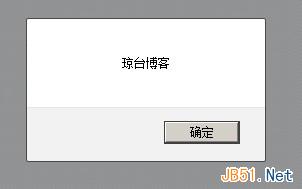
Let’s take a look at the result of having more formal parameters than actual parameters
function say(a,b){
alert('a 的值是 '+a+'\nb 的值是 '+b);
}
say('Using arguments in JavaScript to obtain the number of parameters passed by a function_javascript skills');Execution results
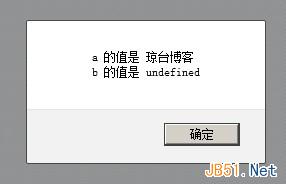
a corresponds to the first actual parameter "Qiongtai Blog", b has no corresponding actual parameter, so the value is undefined
arguments object
In fact, sometimes when the program design is more complex, we do not specify the number of parameters and use them flexibly. There is an array arguments in the function that is specially used to store the actual parameter group. Through arguments we can know the number and value of the actual parameters.
function arg(){
var str = '总共传了'+arguments.length+'个参数
';
for(var i=0;i<arguments.length;i++){
str += '第'+(i+1)+'个参数值:'+arguments[i]+'\n';
}
alert(str);
}
arg('Using arguments in JavaScript to obtain the number of parameters passed by a function_javascript skills','PHP博客','WEB技术博客');Execution results
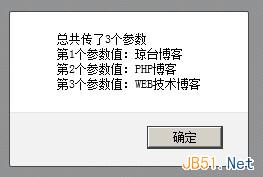
In the above example, we defined the function arg and did not specify formal parameters for it. Instead, we used the arguments object to receive actual parameters, which is very flexible.
For example, we can use it to calculate the smallest number in a set of numbers, no matter how many numbers there are in the set. Such as the following code:
function arg(){
var tmp = 0, str = '在 ';
for(var i=0;i<arguments.length;i++){
for(var g=0;g<arguments.length;g++){
if(arguments[g]<arguments[i]){
tmp = arguments[g];
}
}
str += arguments[i]+',';
}
alert(str.substr(0,str.length-1)+' 里最小的值是 '+tmp);
}
arg(200,100,59,3500);Execute the comparison results of four numbers 200, 100, 59, 3500
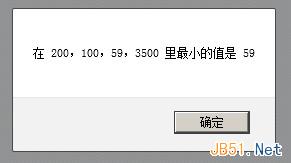
We are adding two numbers, 5 and 60
function arg(){
var tmp = 0, str = '在 ';
for(var i=0;i<arguments.length;i++){
for(var g=0;g<arguments.length;g++){
if(arguments[g]<arguments[i]){
tmp = arguments[g];
}
}
str += arguments[i]+',';
}
alert(str.substr(0,str.length-1)+' 里最小的值是 '+tmp);
}
arg(200,100,59,3500,5,60);Execute the comparison results of six numbers: 200, 100, 59, 3500, 5, 60
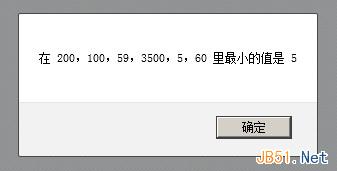
Based on the results of the two operations, we found that no matter how many numbers we pass in, the results can be compared correctly. arguments are generally used where the number of actual parameters is variable. For example, in the example above, you can pass 5 numbers for comparison, or you can pass 100 numbers for comparison.

Hot AI Tools

Undresser.AI Undress
AI-powered app for creating realistic nude photos

AI Clothes Remover
Online AI tool for removing clothes from photos.

Undress AI Tool
Undress images for free

Clothoff.io
AI clothes remover

AI Hentai Generator
Generate AI Hentai for free.

Hot Article

Hot Tools

Notepad++7.3.1
Easy-to-use and free code editor

SublimeText3 Chinese version
Chinese version, very easy to use

Zend Studio 13.0.1
Powerful PHP integrated development environment

Dreamweaver CS6
Visual web development tools

SublimeText3 Mac version
God-level code editing software (SublimeText3)

Hot Topics
 How to implement an online speech recognition system using WebSocket and JavaScript
Dec 17, 2023 pm 02:54 PM
How to implement an online speech recognition system using WebSocket and JavaScript
Dec 17, 2023 pm 02:54 PM
How to use WebSocket and JavaScript to implement an online speech recognition system Introduction: With the continuous development of technology, speech recognition technology has become an important part of the field of artificial intelligence. The online speech recognition system based on WebSocket and JavaScript has the characteristics of low latency, real-time and cross-platform, and has become a widely used solution. This article will introduce how to use WebSocket and JavaScript to implement an online speech recognition system.
 WebSocket and JavaScript: key technologies for implementing real-time monitoring systems
Dec 17, 2023 pm 05:30 PM
WebSocket and JavaScript: key technologies for implementing real-time monitoring systems
Dec 17, 2023 pm 05:30 PM
WebSocket and JavaScript: Key technologies for realizing real-time monitoring systems Introduction: With the rapid development of Internet technology, real-time monitoring systems have been widely used in various fields. One of the key technologies to achieve real-time monitoring is the combination of WebSocket and JavaScript. This article will introduce the application of WebSocket and JavaScript in real-time monitoring systems, give code examples, and explain their implementation principles in detail. 1. WebSocket technology
 How to implement an online reservation system using WebSocket and JavaScript
Dec 17, 2023 am 09:39 AM
How to implement an online reservation system using WebSocket and JavaScript
Dec 17, 2023 am 09:39 AM
How to use WebSocket and JavaScript to implement an online reservation system. In today's digital era, more and more businesses and services need to provide online reservation functions. It is crucial to implement an efficient and real-time online reservation system. This article will introduce how to use WebSocket and JavaScript to implement an online reservation system, and provide specific code examples. 1. What is WebSocket? WebSocket is a full-duplex method on a single TCP connection.
 How to use JavaScript and WebSocket to implement a real-time online ordering system
Dec 17, 2023 pm 12:09 PM
How to use JavaScript and WebSocket to implement a real-time online ordering system
Dec 17, 2023 pm 12:09 PM
Introduction to how to use JavaScript and WebSocket to implement a real-time online ordering system: With the popularity of the Internet and the advancement of technology, more and more restaurants have begun to provide online ordering services. In order to implement a real-time online ordering system, we can use JavaScript and WebSocket technology. WebSocket is a full-duplex communication protocol based on the TCP protocol, which can realize real-time two-way communication between the client and the server. In the real-time online ordering system, when the user selects dishes and places an order
 Simple JavaScript Tutorial: How to Get HTTP Status Code
Jan 05, 2024 pm 06:08 PM
Simple JavaScript Tutorial: How to Get HTTP Status Code
Jan 05, 2024 pm 06:08 PM
JavaScript tutorial: How to get HTTP status code, specific code examples are required. Preface: In web development, data interaction with the server is often involved. When communicating with the server, we often need to obtain the returned HTTP status code to determine whether the operation is successful, and perform corresponding processing based on different status codes. This article will teach you how to use JavaScript to obtain HTTP status codes and provide some practical code examples. Using XMLHttpRequest
 JavaScript and WebSocket: Building an efficient real-time weather forecasting system
Dec 17, 2023 pm 05:13 PM
JavaScript and WebSocket: Building an efficient real-time weather forecasting system
Dec 17, 2023 pm 05:13 PM
JavaScript and WebSocket: Building an efficient real-time weather forecast system Introduction: Today, the accuracy of weather forecasts is of great significance to daily life and decision-making. As technology develops, we can provide more accurate and reliable weather forecasts by obtaining weather data in real time. In this article, we will learn how to use JavaScript and WebSocket technology to build an efficient real-time weather forecast system. This article will demonstrate the implementation process through specific code examples. We
 How to get HTTP status code in JavaScript the easy way
Jan 05, 2024 pm 01:37 PM
How to get HTTP status code in JavaScript the easy way
Jan 05, 2024 pm 01:37 PM
Introduction to the method of obtaining HTTP status code in JavaScript: In front-end development, we often need to deal with the interaction with the back-end interface, and HTTP status code is a very important part of it. Understanding and obtaining HTTP status codes helps us better handle the data returned by the interface. This article will introduce how to use JavaScript to obtain HTTP status codes and provide specific code examples. 1. What is HTTP status code? HTTP status code means that when the browser initiates a request to the server, the service
 How to use insertBefore in javascript
Nov 24, 2023 am 11:56 AM
How to use insertBefore in javascript
Nov 24, 2023 am 11:56 AM
Usage: In JavaScript, the insertBefore() method is used to insert a new node in the DOM tree. This method requires two parameters: the new node to be inserted and the reference node (that is, the node where the new node will be inserted).





